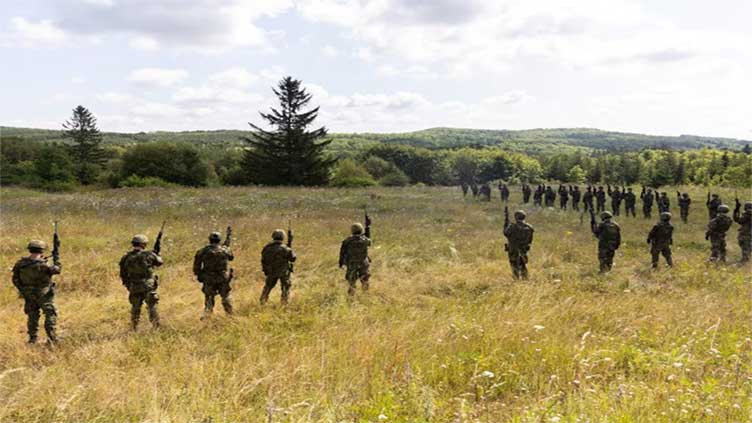Eastern Europe's armies struggle to enlist young people with war not far away

World
In 2021 the Czechs reached 56% of their recruiting goal, rising to 85% in 2022, army data shows
VALEC, Czech Republic (Reuters) – As instructors shout commands, dozens of students taking part in a pilot Czech army programme aimed at boosting flagging enlistment numbers crawl through forest scrub carrying combat rifles and learning proper shooting positions.
Like most former Soviet-satellite states now in NATO, the Czech Republic has missed recruitment targets for years and struggled to maintain troop levels. This has left army units understaffed and unable to reach combat readiness, with Russia’s invasion of Ukraine, on eastern Europe's fringes, a stark reminder of Moscow's potential threat to the region.
Around 80 Czech high school students chose to spend part of their summer learning about army life at the four-week training programme being conducted in a closed military zone 94 km (58 miles) west of the capital Prague.
But General Karel Rehka, the Czech armed forces chief, has called the current system unsustainable.
He told Reuters the programme run by the 4th Rapid Deployment Brigade - an army unit operating at just 50 percent of capacity due to a dearth of soldiers - gives students an early taste of army life.
"We want to deter any potential adversary in the future," Rehka said. "If we don't do anything about the lack of human resources in the military..., it may mean that we won't be able to preserve our peace and to deter any potential enemy."
In 2021 the Czechs reached 56 percent of their recruiting goal, rising to 85 percent in 2022, according to the most recent army data.
The Czechs are not alone. Countries across eastern Europe have struggled to sign up new soldiers and keep experienced ones in a region where Poland, Hungary, Romania and Slovakia all share a border with Ukraine.
"We cannot do anything without people - if we modernise equipment and don't have enough competent people and motivated people, that is all wasted money," Rehka said.
EUROPEAN-WIDE PROBLEM
Western European nations in NATO face similar challenges. In July Reuters reported that NATO will need between 35 and 50 extra brigades to fully realise its new plans to defend against any attack on alliance territory from Russia.
But the issue hits closer to home for the eastern European countries that spent four decades under Soviet domination and have long warned about the threat from a more assertive Russia under President Vladimir Putin.
"We also see the probability of Russian aggression against us as not impossible...within a few years," Czech former deputy defence minister Tomas Kopecny, Prague's envoy on Ukraine reconstruction issues, told Reuters.
"So in case Russia attacks, we need to know we can count on a certain amount of soldiers and capabilities."
Governments have turned to digital marketing campaigns, raised enlistment bonuses and considered options include a Czech defence ministry decree, effective Sept. 1, lowering the medical requirements for career soldiers, reservists and new recruits.
But with unemployment rates low across eastern Europe, a major challenge is convincing young people to enlist for less money than they can earn in the private sector.
"We have challenges. They are related to the fact that the labour market here is very competitive,” Major General Karol Dymanowski, First Deputy Chief of the General Staff of Poland's armed forces, told Reuters.
NEW GENERATION OF SOLDIERS NEEDED
In Poland, government and military officials say they are hitting recruiting targets, planning to increase the recruitments limits, but critics question whether the goal to build an army comprising 300,000 soldiers is realistic.
Eastern Europe's biggest country is also seeking to boost defence spending to near 5% of GDP and recently launched a recruitment campaign dubbed “Holidays With the Army”, which provides basic military training for citizens aged 18 to 35 over 28 days.
But defence ministry data show while the number of recruits rose in the latest available figures, a record 9,000 professional soldiers left the service in 2023.
While Dymanowski said it is a "natural process", Colonel Bogdan Sowa, head of the Organization and Recruitment Directorate in Poland's General Staff, explained there is a considerable group who leave the army just a few years after starting service. “We are trying to prepare more attractive offers for them, creating new financial incentives,” said Sowa.
Hungary's military – which has not published updated recruitment numbers – has launched a media campaign using billboards, advertisements and a military-themed TV series to be aired by the end of 2024 to find new soldiers.
In Romania, the government began enlistment drives after recent defence ministry data showed 43 percent of officers’ positions were unfilled, along with the positions of 23 percent of soldiers and other professional ranks.
Romania has four Patriot missile defence batteries but only two are operational, while the government has bought a number of F-16 fighter jets but lacks enough trained pilots to fly them.
"One must look at what laws need to be changed, not only in Romania but in other countries, to incentivise these people (serving soldiers) to stay,” a defence source told Reuters.
Romania and other countries place their hopes on a new generation of soldiers like Czech high school student John Dunka who is taking part in the army's summer camp near Prague and plans to enlist when he finishes school.
"Wearing this uniform includes a sense of pride," Dunka said, holding an unloaded Bren 2 combat rifle while on a break from military drills. "With all that has happened in the world, I'm glad I can participate in a camp like this."


